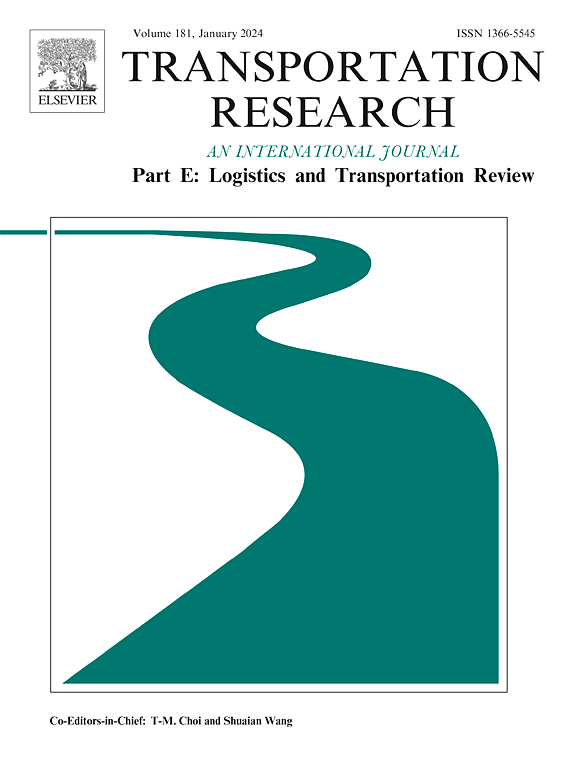Modeling and analyzing ride-hailing market equilibrium considering drivers’ multi-homing choice behavior
IF 8.3
1区 工程技术
Q1 ECONOMICS
Transportation Research Part E-Logistics and Transportation Review
Pub Date : 2025-03-15
DOI:10.1016/j.tre.2025.104055
引用次数: 0
Abstract
The success of ride-hailing services has engendered the rise of multiple service platforms in a competitive market. To this end, drivers are widely observed delivering services on more than one platform simultaneously to maximize their profits, referred to as the “multi-homing” behavior. Drivers’ spontaneous multi-homing has the potential to mitigate market fragmentation but may also intensify their competition for passengers across platforms. This study aims to address the impacts brought by multi-homing drivers on the stakeholders of ride-hailing services. We employ a game-theoretical framework to model the choice of freelance drivers on whether and how to multi-home, as well as the decision of passengers on which platform to attend in an asymmetric market with loyal drivers. On account of the multi-homing behavior, we specifically identify the effective supply of platforms dictating the matching efficiency behind the seeming blossom of supply. On this basis, we compare the equilibrated market under drivers’ multi-homing behavior with a monopoly market and another equilibrated market having drivers single-homing on one platform. Our finding suggests that compared to a monopoly, multi-homing alleviates the wild-goose chase (WGC) dilemma and benefits all stakeholders in supply shortages due to its weaker matching efficiency, resulting in a rational demand level and more available vehicles. In contrast to the benchmark where drivers single-home, multi-homing enhances overall system performance due to the enlarged pool of vacant vehicles for passengers. Specifically, it strengthens the supply advantage of dominant platforms in more balanced markets, while facilitating the expansion of weaker platforms in highly asymmetric markets with a moderate freelance fleet. Extensive numerical results derived from real-world datasets indicate that multi-homing becomes a viable strategy for freelance vehicles in markets with limited supply, and multi-homing contributes to the growth of less influential platforms in practice.
打车服务的成功促使多个服务平台在竞争激烈的市场中崛起。为此,人们普遍观察到司机同时在多个平台上提供服务,以实现利润最大化,这种行为被称为 "多平台 "行为。司机自发的 "多平台 "行为有可能缓解市场分化,但也可能加剧他们在不同平台上对乘客的争夺。本研究旨在探讨 "多地接单 "司机对打车服务利益相关者的影响。我们采用博弈论框架来模拟自由职业司机对是否和如何多次返程的选择,以及乘客在有忠诚司机的非对称市场中决定去哪个平台的决策。考虑到多重到家行为,我们特别确定了平台的有效供给,这决定了看似百花齐放的供给背后的匹配效率。在此基础上,我们比较了司机多平台行为下的平衡市场与垄断市场,以及司机单平台行为下的另一个平衡市场。我们的研究结果表明,与垄断市场相比,司机多地接送缓解了 "野鹅追逐"(WGC)困境,由于其匹配效率较低,在供应短缺的情况下对所有利益相关者都有利,从而导致合理的需求水平和更多的可用车辆。与司机单次回家的基准相比,多次回家由于为乘客提供了更多的空闲车辆而提高了系统的整体性能。具体来说,在较为均衡的市场中,它加强了优势平台的供应优势,而在自由车队适中的高度不对称市场中,它促进了弱势平台的扩张。通过实际数据集得出的大量数值结果表明,在供应有限的市场中,多重归宿成为自由车辆的一种可行策略,而且多重归宿在实践中有助于影响力较小的平台的发展。
本文章由计算机程序翻译,如有差异,请以英文原文为准。
求助全文
约1分钟内获得全文
求助全文
来源期刊
CiteScore
16.20
自引率
16.00%
发文量
285
审稿时长
62 days
期刊介绍:
Transportation Research Part E: Logistics and Transportation Review is a reputable journal that publishes high-quality articles covering a wide range of topics in the field of logistics and transportation research. The journal welcomes submissions on various subjects, including transport economics, transport infrastructure and investment appraisal, evaluation of public policies related to transportation, empirical and analytical studies of logistics management practices and performance, logistics and operations models, and logistics and supply chain management.
Part E aims to provide informative and well-researched articles that contribute to the understanding and advancement of the field. The content of the journal is complementary to other prestigious journals in transportation research, such as Transportation Research Part A: Policy and Practice, Part B: Methodological, Part C: Emerging Technologies, Part D: Transport and Environment, and Part F: Traffic Psychology and Behaviour. Together, these journals form a comprehensive and cohesive reference for current research in transportation science.

 求助内容:
求助内容: 应助结果提醒方式:
应助结果提醒方式:


